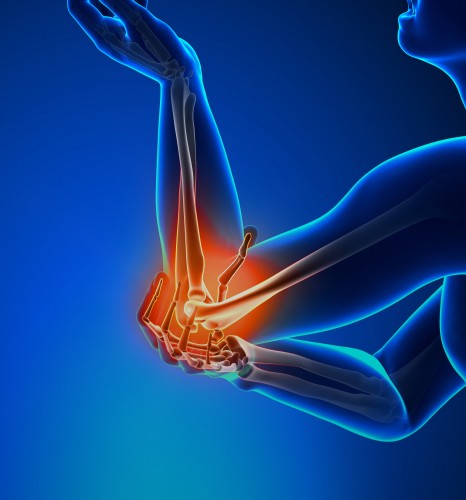Online Enquiry Form

Overview
The condition “tennis elbow” (lateral epicondylitis) is an injury to the tendons of the outer elbow which are mainly used when extending our wrist, as when using a tennis racket. The pain and inflammation from elbow tendonitis often results in time off work, or absence from sport.
Sufferers of tennis elbow are often in the 35-50 year old bracket, however, it can happen at any age. Usually, the elbow will be painful to touch, and wrist and finger extension is difficult or painful too. Tennis elbow may be caused by an acute episode of prolonged activity, such as one long game of tennis, or it may be the result of frequent episodes of acute tennis elbow, resulting in a chronic inflammatory response.
Acute tennis elbow can be managed by seeing your GP for pain and anti-inflammatory medication or your physiotherapist for ice massage and stretching treatments. In the case of chronic tennis elbow where non-surgical treatments may have failed, surgery is an option to relieve your pain and regain your strength.

Symptoms
Tennis elbow may have the following symptoms:
- Point tenderness on the outside of the elbow.
- Pain extending from the elbow down the forearm when extending the wrist and fingers.
- Weakness when extending the wrist and fingers.
Causes
Acute Tennis Elbow
Acute tennis elbow is caused by a prolonged episode of wrist and finger extension, like holding a tennis racket or typing, where the activity continues into fatigue and beyond. As the activity continues, the muscle tendons of the elbow experience swelling and wear against the bones of the elbow and do not get a chance to recover before becoming damaged and inflamed.
Chronic Tennis Elbow
Chronic tennis elbow is where the acute episodes repeat frequently, over 6 months or more, causing persistent elbow pain and ongoing impact on your day-to-day life.
Sports Injuries
Tennis is the obvious sport responsible for causing tennis elbow, however, racket sports of all kinds such as squash, badminton and ping pong may cause tennis elbow if the activity is prolonged for long enough. The heavier the object being hit against the racket, the quicker the onset of the condition.
Workplace Injuries
Painters, plasterers, carpenters and also office workers who have poor ergonomics while typing commonly experience tennis elbow. Cooks and butchers, who are lifting heavy pans and meat cleavers, frequently chopping, cutting, grating or stirring as part of their job can also experience tennis elbow due to the weight and frequency of manipulating such items.
Diagnosis
When diagnosing tennis elbow the following is taken into consideration:
- Taking the patient’s history to determine the cause of the injury.
- Understanding it in the context of the patient’s age.
- Consulting about the need to use their elbow again quickly.
A physical examination including observing and testing the patient’s elbow is useful to determine the specific location of pain, any bruising and or loss of function of the elbow. Pain on the outside of the elbow and loss of strength when extending the wrist and fingers are positive indicators of tennis elbow. The waiter’s tip stretch test is a specific physical examination test used to confirm tennis elbow. A comparison to the patient’s non-affected side is always useful to determine the patient’s sense of normal.
Imaging such as xray and MRI and further diagnostic tests are used to determine whether there are any fractures contributing to the condition and to determine if the problem is a more extensive one.
Treatment
Treatment of tennis elbow should always begin with a thorough diagnosis of your condition to understand the severity in the context of your age and how your elbow function may impact your job, sport, and life. Between 80-95% of acute tennis elbow conditions can be improved by simple conservative treatments. Things like NSAID medications, taping, bracing, stretching and avoiding painful activities should improve your condition. In patients suffering from chronic tennis elbow, if conservative measures do not help the condition, surgery may be the right option for you.
Surgical Treatment
Tennis elbow surgical repair is a very small operation providing rapid relief. Chronic tennis elbow causes damage to the extensor tendons of the forearm. The goal of tennis elbow repair surgery is to release and repair the tendon back to its attachment at the elbow. Dr Gupta will assess the severity of chronic tennis elbow and determine the best surgical repair and fixation.
Knotless Anchor Fixation: An incision is made over the extensor tendons on the lateral side of the elbow where Dr Gupta will release the tendons, clean them from inflamed tissue and reattach them to the lateral epicondyle.
Post Operative Rehabilitation
You will achieve the best surgical outcome if you follow up surgery with a matching course of rehabilitation. Following surgery, Dr Gupta will outline the most appropriate rehabilitation protocol for your physiotherapist to follow and communicate with your healthcare team to ensure that you receive the best post-operative treatment.
Please contact our friendly team on 02 9687 8344 or make an online enquiry here.

Dr Manish Gupta | MBBS FRACS FAOrthoA
Dr Manish Gupta is a renowned expert surgeon in the field of orthopaedic surgery specialising in upper limb including shoulder, elbow and wrist.